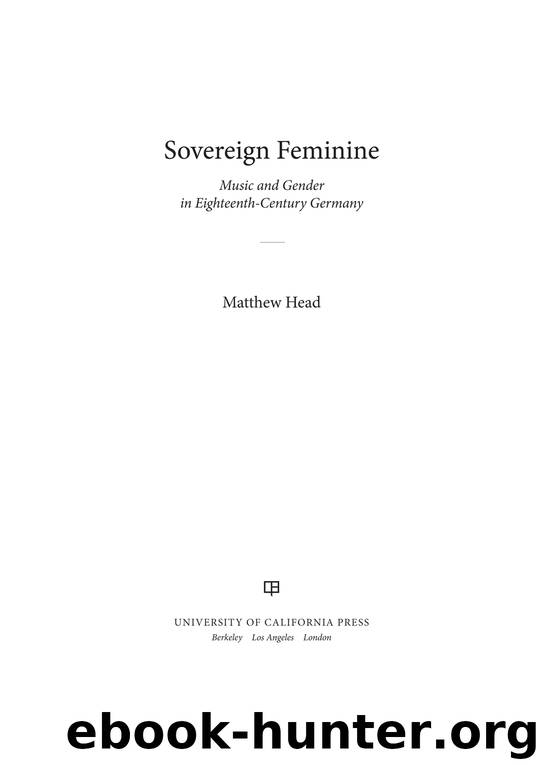Sovereign Feminine by Head Matthew

Author:Head, Matthew
Language: eng
Format: epub
ISBN: 9780520273849
Publisher: University of California Press
WESTENHOLZ’S COMPOSITIONS
Compose she did. Her works list (compiled here as table 4), which contains many newly uncovered pieces, represents one of the most substantial bodies of music of any female composer of the eighteenth century. To provide an overview, and as a reference for future commentary, I have catalogued her opus with “SW” numbers, organized by conventional genre categories. As far as I have been able to establish, her output comprises eleven keyboard pieces (including five solo sonatas), thirty-two German songs (mostly with keyboard accompaniment but two existing in versions with string orchestra), along with miscellaneous and lost pieces, including one for glass harmonica. This output is dominated by the keyboard, as both a solo instrument and, in the songs, an often elaborate, loquacious, even intrusive participant. (Westenholz did not follow the older convention of Reichardt and J.A.P. Schulz for unobtrusive accompaniments.) Although there is a small literature on Westenholz as a composer of songs, there is nothing on her keyboard music, which was at the center of her activity. This chapter seeks clarity, where it is available, about her career, her music, and the aesthetic debates triggered by both. Much of the biographical and source information reported in the twentieth century is inconsistent and unreliable.10 For example, Dieter Härtwig’s entry on the composer in The New Grove Dictionary of Women Composers states that “a manuscript chronicle of the Westenholz family, letters and other documents are held at the Wissenschaftliche Allgemeinbibliothek (formerly Mecklenburgische Landesbibliothek),” an institution now called the Landesbibliothek Mecklenburg- Vorpommern; in Die Musik in Geschichte und Gegenwart, however, the same writer gave a different location for the chronicle, specifically “im Mecklenburgischen Staatsarchiv Schwerin,” an archive now called the Landeshauptarchiv Schwerin.11 But these confusions conceal another: the chronicle never existed.12 What do survive are court records containing contractual information, receipts, and petitions, which I use here to help set Westenholz’s biography on a more secure footing.13
Although firm evidence is lacking, much of Westenholz’s music appears to date from between around 1797 to about 1811: that is, the period of her most intense activity at court as the chief representative of keyboard culture and of her concerts beyond Ludwigslust. Some of the German songs were probably written for a short-lived musical society that linked court and town in the late 1790s; the piano sonatas appear to encompass easy, pedagogically oriented pieces, perhaps for royal children, and more ambitious works written (in C.P.E. Bach’s phrase about works of his own) “in complete freedom and for my own use.”14 A single choral work, with orchestral passages employing “Turkish,” or Janissary, instruments, probably formed a festival piece for the celebration of a new year.15 Among the lost works are those for glass harmonica, of which Westenholz was a major exponent. A report in the Allgemeine musikalische Zeitung of 1804 refers to her playing her own pieces for that instrument in Berlin. All that survives of her involvement with the harmonica, however, is a poem published in a Mecklenburg periodical of 1789 in praise of her performance on this otherwordly instrument.
Download
This site does not store any files on its server. We only index and link to content provided by other sites. Please contact the content providers to delete copyright contents if any and email us, we'll remove relevant links or contents immediately.
The Cello Suites by Eric Siblin(770)
Hungarian by Hungarian(509)
Bach's Musical Universe by Christoph Wolff(509)
Secret Lives of Great Composers by Elizabeth Lunday(420)
Franz Liszt by Saffle Michael(418)
Stravinsky by Stephen Walsh(410)
Curious and Modern Inventions: Instrumental Music as Discovery in Galileo's Italy by Rebecca Cypess(401)
The Complete Idiot's Guide to Classical Music by Sherman Robert(390)
The Romantic World of Puccini: A New Critical Appraisal of the Operas by Iris J. Arnesen(378)
Music for Silenced Voices by Wendy Lesser(366)
Music In The Baroque Era - From Monteverdi To Bach by Manfred F. Bukofzer(365)
The Beethoven Syndrome by Mark Evan Bonds(354)
The Detroit Symphony Orchestra by Harris Laurie Lanzen; Ganson Paul;(343)
The Cambridge Companion to Stravinsky by Jonathan Cross(339)
Chopin's Piano by Paul Kildea(334)
Music for Life: 100 Works to Carry You Through by Fiona Maddocks(332)
Dangerous Melodies by Jonathan Rosenberg(320)
Rachmaninoff's Complete Songs by Richard D. Sylvester(318)
The Lady from Arezzo by Alfred Brendel(289)
